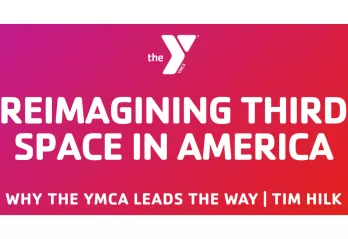Reimagining Third Space in America: Why the YMCA Leads the Way

In 1989, sociologist Ray Oldenburg introduced the concept of the “third place” in The Great Good Place1, defining it as a neutral, informal gathering spot apart from home and work where conversation, sociability and civic flourishing take place. Traditional examples include cafés, coffee shops, parks or libraries. Yet as modern society evolves, the classic third place falls short of meeting deeper human needs. Today, Americans crave the integration of spirit, mind and body—and in this broader sense, no institution serves that purpose better than the YMCA.
Oldenburg emphasized seven characteristics of third places: openness, informality, accessibility, equality among patrons, presence of regulars, conversational focus and a light-hearted mood. Analysis of community-centered venues confirms their impact on quality of life—third places foster belonging, reduce loneliness and are tied to perceived community well-being. But the spaces that succeed today must not only be neutral zones—they must address the wellness needs of each of us. That’s where the YMCA’s unique mission and programming come into play.
Founded in 1844 and deeply shaped by the fourfold emphasis on spiritual, intellectual, physical and social development, the YMCA’s emblem itself—the inverted red triangle—symbolizes that holistic approach. Across the U.S., local Y’s offer programs that feed all three dimensions: fitness and wellness programs; youth and lifelong education; community building and socialization initiatives. The result is a place where people gather for more than just conversation—though conversation thrives there too.
As a third place, the YMCA surpasses venues like coffee shops in several ways:
- Purposeful community integration. Unlike establishments that prioritize commerce, YMCAs embed themselves in neighborhoods as long-term anchors. Their programs serve diverse populations, offering affordable childcare, teen and family activities, health interventions like diabetes prevention and safe housing partnerships in some regions. That integration creates a depth of social infrastructure often missing in purely commercial venues.
- Holistic enrichment. Regulars at a third place traditionally come for social ease; at the Y, they can swim, take classes, volunteer and attend workshops—all in one location.
- Belonging and equity. Third places are characterized in part by a straightforward sense of equality among participants. . YMCAs are often sliding-scale or scholarship-supported and welcome all ages, backgrounds and abilities. Their civic mission includes youth development and social responsibility, undergirded by inclusivity.
- Resilience in modern challenges. As classic third places decline—due to suburbanization, car-dependency and the commodification of public gathering spots—the YMCA stands out as a resilient social glue. Researchers have called attention to the shrinking of third places and the public health consequences: increased isolation, reduced social capital and heightened inequity. YMCAs, however, deliberately operate as hubs that can fill those gaps.
Importantly, this argument isn’t a YMCA advertisement. Rather, it reframes what “third space” means in contemporary America. Loneliness, burnout, cultural fragmentation and disconnection demand more from communal institutions than a spot to sip coffee or check email. People seek belonging and meaning. The YMCA, grounded in its founding mission yet adaptive to modern needs, delivers on all.
Indeed, for many communities, the YMCA is the third space that nurtures spirit, mind and body and does so with intentionality, not happenstance. As businesses, nonprofits and civic leaders consider where people might belong beyond home or work, the Y offers a proven model of inclusive social infrastructure.
In an era when isolation undermines social cohesion and personal flourishing, it’s time to see the YMCA as the modern third space America needs. As the Y continues to identify itself as a Well-Being place, we encourage community to utilize, invest and embrace the Y as the ultimate third space!
- Oldenburg, R. (1989). The great good place: Cafés, coffee shops, bookstores, bars, hair salons, and other hangouts at the heart of a community. Paragon House.
- Finlay, J., Esposito, M., Kim, M. H., Gomez-Lopez, I., & Clarke, P. J. (2019). Closure of “third places”? Exploring potential consequences for collective health and wellbeing. Health & Place, 60, 102225. https://doi.org/10.1016/j.healthplace.2019.102225
(Complete text at https://pmc.ncbi.nlm.nih.gov/articles/PMC6934089/)